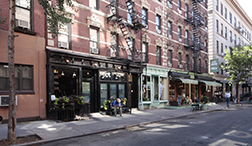
 Landmarks Preservation Commission311
Landmarks Preservation Commission311 Search all NYC.gov websites
Search all NYC.gov websites
Press Release
FOR IMMEDIATE RELEASE:
Tuesday, December 13, 2016
COMMISSION DESIGNATES SULLIVAN-THOMPSON AS NEW YORK CITY HISTORIC DISTRICT
LPC Grants Protection to Historic District with Rich Immigrant History

(New York, NY)- The Landmarks Preservation Commission today unanimously approved the Sullivan-Thompson Historic District in Manhattan. The new district consists of approximately 157 buildings, including row houses, tenements, commercial structures, and institutions. The district’s streetscapes illustrate the growth of the area from a residential row house neighborhood to a vibrant, mixed-use, working-class district. The Sullivan-Thompson Historic District is significant for its immigrant history, including its Italian American population. Today’s designation brings the number of New York City Historic Districts to 140.
“From its Federal and Greek Revival style row houses to its tenement buildings and picturesque storefronts, the Sullivan-Thompson Historic District represents more than a century of residential construction,” said Commission Chair Meenakshi Srinivasan. “The district’s rich history of immigration and diversity typifies New York’s essence, one that proudly continues today.”
“The South Village is a neighborhood of immense historical and architectural significance,” said Council Member Corey Johnson. “Because of this designation, future generations of New Yorkers will be able to experience the unique sense of place and time that this neighborhood imparts. In a time of unprecedented real estate development, the Sullivan Thompson Historic District will ensure the survival of this unique enclave. The Landmarks Preservation Commission has done a spectacular job with this designation, and I thank Chair Meenakshi Srinivasan, her staff and colleagues on the Commission for their outstanding work. I also want to thank the people of the Village and the Greenwich Village Society for Historic Preservation, who made this possible through their years of advocacy.”
The Sullivan-Thompson Historic District is bounded by West Houston Street to the North, Watts Street to the South, Sixth Avenue to the West and Thompson Street to the East. The buildings of this largely residential district are primarily tenements, and are distinct from those in the neighboring SoHo-Cast Iron Historic District to the east, and the Charlton-King-Vandam Historic District to the west. The proposed district also contains several 19th century institutional buildings, including the Church of St. Anthony of Padua and St. Anthony’s School.
Many of the district’s row houses were built in the early 19th century, while the majority of its tenements, lofts, and institutional buildings were built in the mid-19th century, when the neighborhood was transformed by an influx of immigrants and a significant increase in population. The majority of new immigrants were Irish and German, though there were sizable populations from France, England, and other Western European countries.
With the wave of immigration in the mid-19th century, several of the district’s row houses were enlarged to accommodate families, and storefronts were frequently added to the lower stories to accommodate new businesses. Other row houses were demolished and replaced with tenement buildings, which typically featured commercial ground floors and were designed in the Italianate and neo-Grec styles. Successive laws enacted to improve the living conditions of immigrants, like the Tenement House Act of 1879, led to substantial changes in tenement construction. These later tenements were often designed in the Queen Anne and Renaissance Revival styles.
In addition to European immigrants, the blocks that comprise the Sullivan-Thompson Historic District were also home to a significant African American population. Sullivan Street between Broome and Spring Streets had 21 buildings with African American tenants by 1870. A number of saloons, such as the Knickerbocker at 57 Sullivan Street, controversially served a multi-racial, non-segregated clientele.
By the 1890s, the immigrant residents of the Sullivan-Thompson Historic District were overwhelmingly Italian in origin, making the area one of the most densely-populated Italian communities in New York’s history. Italian immigrants created a vibrant community anchored by the church of St. Anthony of Padua and a number of Italian-owned businesses.
Nestled between a number of major thoroughfares and designated historic districts, today the proposed Sullivan-Thompson Historic District is a distinctive enclave that retains its unique sense of place.
Contact:
Damaris Olivo / 212-669-7938, dolivo@lpc.nyc.gov
###
The Landmarks Preservation Commission is the mayoral agency responsible for protecting and preserving New York City's architecturally, historically and culturally significant buildings and sites. Since its creation in 1965, LPC has granted landmark status to more than 36,000 buildings and sites, including 1394 individual landmarks, 117 interior landmarks, 10 scenic landmarks, and 140 historic districts and extensions in all five boroughs. Under the City's landmarks law, considered among the most powerful in the nation, the Commission must be comprised of at least three architects, a historian, a realtor, a planner or landscape architect, as well as a representative of each borough.


